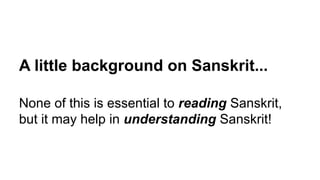Sanskrit intro language
- 1. A little background on Sanskrit... None of this is essential to reading Sanskrit, but it may help in understanding Sanskrit!
- 2. Sanskrit is kind of like Latin Sanskrit shares a lot of features with Latin, especially Latin in the Middle Ages.. 1. The language of higher education & religion, but not generally anyone¡¯s native language. 2. Major influence on the region¡¯s other languages. Around half of the words in many Indian languages are derived from Sanskrit. 3. Heavily inflected! Words change to fit grammatical use. English does this with pronouns to show subject/object/possessive (he/him/his), and verbs to show past/present and number (walk/walked. he walks / they walk). Sanskrit does this with nearly everything, and has many forms for each thing.
- 3. Sanskrit is an Indo-European language. This is why many Sanskrit words sound like related English words, especially English words derived directly from Latin and Greek roots. ¡ñ ¡°pada¡± (foot) is the same root word found in ¡°pedestrian¡± and ¡°podiatrist¡±. ¡ñ ¡°janu¡± (knee) is the same root word found in ¡°genuflect¡± (to kneel). ¡ñ ¡°deva¡± (god) is from the same root as ¡°divine¡±. ¡ñ ¡°nava¡± (boat) is from the same root as ¡°navy¡±. So at least there is one thing to make Sanskrit a little easier! And Like Latin, and English...
- 4. Example: Comparing the numbers in various Indo-European languages shows there is clearly a relationship. The connection to the Germanic-derived words in English are less obvious, because their consonants shifted over time. This is how the Latin ¡°ped-¡± became ¡°foot¡± in English, and ¡°dec-¡± became ¡°ten¡±. It does follow a clear and fairly consistent pattern though. Curious to learn more on that?
- 5. SIDE NOTE: Language in Modern India Language is a highly political issue in India. There are 22 officially recognized languages, and a few hundred smaller languages. Hindi is spoken by around 40% the population of India, but that is almost entirely concentrated in Northern India. Southern India is very linguistically diverse, with many different regionally dominant languages, each with less than 10% of India¡¯s overall population. English is the most common second language among educated Indians, and is still used in government. A good deal of higher education in India is in English. While many Indians study Sanskrit for cultural reasons, it is almost never used conversationally, except in small groups specifically trying to promote its use.
- 6. Variations in Pronunciation The diversity of languages in India is why you hear so much variability in the pronunciation of Sanskrit words by native Indian speakers, especially when they are speaking freely, rather than reciting or chanting. They are likely to pronounce the Sanskrit terminology as it is said in their native language (Hindi, Gujarati, Tamil, Bengali, etc), rather than strict Sanskrit pronunciation. The most common sources of confusion have already been mentioned: 1. Silent ¡°a¡±, especially as final sound in a word 2. Distinct W and V sounds instead of one W/V sound 3. Different S/SH distinction 4. PH and TH pronounced as in English 5. Dot indicating M/N/NG 6. Variation in the neutral (short a) vowel sound 7. Sound shifts in the long vowels.
- 7. What is a ¡°heavily inflected language¡±? Namaste, namaha, namo, namaskar. All are forms of the same word! You can easily have 20 different forms of a word, depending on usage. In English we primarily use word order (¡°Sara likes dogs.¡± ¡°Dogs like Sara.¡±) and auxiliary words (¡°He drove TO HIS office DURING THE rainstorm BECAUSE OF YOUR letter.¡±) but we still have some things we indicate by using different forms of the word, such as: write, writes, written, writer, writers, writable, writing, wrote, writer¡¯s.
- 8. How are words ¡°inflected¡±? In Sanskrit, so much can be indicated by using different forms of the word. As in English, Sanskrit word forms are usually different endings but sometimes vowels or consonants can shift. Most words follow well defined patterns, but some do not, and the patterns are complex. There are so many forms, that at first it is simplest to just recognize familiar root words, and not worry about learning all of the exact forms until you have more context.
- 9. What can an inflected language do? Because the relationship between the words in a Sanskrit sentence is shown by the form of the word, the position of words and phrases can be freely arranged without altering meaning, giving a great deal of flexibility for composing poetic verse. (Much of Sanskrit writing is in verse.) This also allows very long and complex phrasings to be used. These can be difficult to translate word-for-word.
- 10. Sanskrit loves prepositional compounds There is a tendency in Sanskrit to make everything in a sentence (or paragraph) into a long and complex string of modifiers and tack the subject on at the end, especially in poetic verse. For example, instead of something like ¡°She saw the boy walking home along the road, carrying a basket of bread.¡± Sanskrit might use something like ¡°She saw the bread-basket-carrying, homeward-bound, road-walking boy.¡±
- 11. Letter Combining: Sandhi Because some sounds are awkward to pronounce in combination, and Sanskrit has always placed an emphasis on the sound of the spoken/chanted language, some letter pairs change when they are next to each other. This is most common with vowels: paschima + uttanasana = paschimottanasana Occasionally incompatible consonants will also change chatur+pada = chatushpada This is called ¡°sandhi¡±. It follows a regular, if complicated pattern.










